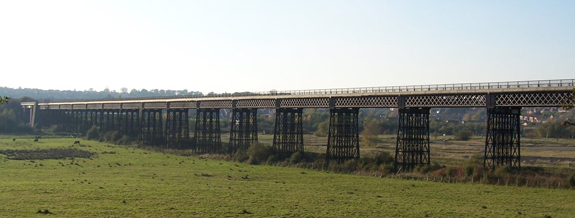
This wrought iron lattice work viaduct is 442 m (1452 ft) long with the rails 18 m (61 ft) above the Erewash River. Most railway viaducts at the time were brick built but the foundations of the Bennerley Viaduct were subject to a great deal of coal mining subsidence, therefore the lighter wrought iron design was chosen. The viaduct was built between May 1876 and November 1877 and formed part of the Great Northen Railway Derbyshire Extension which was built in part to exploit the coalfields in Derbyshire and Nottinghamshire.
The contract was given by the Great Northern Railway (GNR) to Benton & Woodiwiss with the line laid out by, and the viaduct designed by Richard Johnson (Chief Civil Engineer of the GNR); Samuel Abbott was the resident engineer. The viaduct consists of 16 lattice work deck spans, each 23 m (76 ft 7 ins) long supported on wrought iron columns with stone capped blue brick foundations. There were three additional iron skew spans at the Ilkeston end of the viaduct which carried the railway line over the Erewash Canal and the Midland Railway's Erewash Valley Line. A skew span crosses its abutments and or piers at an angle other than a right angle. At the Awsworth end of the viaduct there was a section of embankment (including bridges of more conventional brick construction) which has been demolished. The Nottingham Canal passed under this section. The viaduct was built for the railway line between Awsworth Junction and Derby on the Derbyshire and Staffordshire Line and opened in January 1878.
The only similar viaduct in the United Kingdom was the Halesowen Railway's Dowery Dell (Hunnington or Frankley) Viaduct demolished in 1964. The first Tay Rail Bridge used a similar Lattice work design, it collapsed during a storm in 1879 with the loss of 75 lives.
One other wrought iron railway viaduct still stands in Britain. This is the Meldon Viaduct built for the London and South Western Railway in 1874 (see Meldon Viaduct entry).
The dismantled Crumlin Viaduct finished in 1857 consisted of ten, 46 m (150 ft) long Warren Truss Spans 61 m (200 ft) above the valley floor built for the Taff Vale Extension. This was the tallest viaduct in Great Britain until its demolition in 1965.(see Crumlin entry)
The dismantled Belah Viaduct finished in 1861 consisted of 16 spans with a total length of 320 m (1,040 ft), 60m (196 ft) above the valley floor, built for the South Durham and Lancashire Union Railway. This was the tallest viaduct in England. It was closed in 1962.
A wrought iron viaduct was built at West Meon on the Meon Valley Railway, opened in 1903. This 4-span viaduct stood 19 m (62 ft)high. Built to carry double track, the viaduct only ever carried a single line. The viaduct was demolished in 1955, and only the concrete pedestals and foundations remain.
Bennerley viaduct's wrought iron construction saved it from demolition. Wrought iron structures cannot be cut up with an oxy-acetylene torch and must be taken apart rivet by rivet. As a result, when tenders for demolition were requested the cost was unacceptably high. The viaduct survived to become a Grade II* Listed Structure. It is managed by Sustrans and may yet be used in the future as part of the national foot and cyclepath network. It is on the Buildings at Risk Register.
By road: Off A6096 on the northern outskirts of Nottingham

Picture credit: Tina Cordon at the English language Wikipedia [CC BY-SA 2.5 (http://creativecommons.org/licenses/by-sa/2.5), GFDL (www.gnu.org/copyleft/fdl.html)
Biddle, Gordon, Britain's Historic Railway Buildings, Oxford University Press, ISBN-10: 0198662475 (2003)
Biddle, Gordon & Nock, O.S., The Railway Heritage of Britain : 150 years of railway architecture and engineering, Studio Editions, ISBN-10: 1851705953 (1990)
Biddle, Gordon and Simmons, J., The Oxford Companion to British Railway History, Oxford, ISBN 0 19 211697 5 (1997)
Bonavia, Michael, Historic Railway Sites in Britain, Hale, ISBN 0 7090 3156 4 (1987)
Conolly, W. Philip, British Railways Pre-Grouping Atlas And Gazetteer, Ian Allan Publishing, ISBN 0-7110-0320-3 (1958/97)
Henshaw, Alfred, The Great Northern Railway in the East Midlands, RCTS, ISBN 0-9011-1588-6 (2000)
Jowett, Alan, Jowett's Railway Atlas of Great Britain and Ireland, Patrick Stephens Ltd. ISBN 1-8526-0086-1. (March 1989)
Kingscott, Geoffrey, Lost Railways of Nottinghamshire, Countryside Books, ISBN 1-8530-6884-5 (2004)
Morgan, Bryan, Railways: Civil Engineering, Arrow, ISBN 0 09 908180 6 (1973)
Morgan, Bryan, Railway Relics, Ian Allan, ISBN 0 7110 0092 1 (1969)
Rayner Thrower, W., The Great Northern Main Line. Oakwood Press. ISBN 0-8536-1297-8 (1984)
Simmons, J., The Railways of Britain, Macmillan, ISBN 0 333 40766 0 (1961-86)
Simmons, J. The Victorian Railway, Thames & Hudson, ISBN 0 500 25110X (1991)
Smith, Martin, British Railway Bridges and Viaducts, Ian Allan, ISBN 0 7110 2273 9 (1994)
Turnock, David, An Historical Geography of Railways, Ashgate, ISBN 1 85928 450 7 (1998)
Buildings at Risk Register - Bennerley Viaduct
Forgotten Relics - Listed Bridges and Viaducts